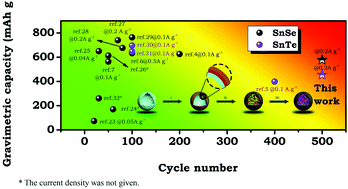Core–shell (nano-SnX/nano-Li4Ti5O12)@C spheres (X = Se,Te) with high volumetric capacity and excellent cycle stability for lithium-ion batteries†
Abstract
Among binary tin chalcogenides as anode materials for lithium-ion batteries, SnSe and SnTe have attracted attention due to their high theoretical volumetric capacity. However, they suffer from sluggish dynamics and serious agglomeration during lithiation/delithiation processes, which leads to inferior cycling performance. This study reports core–shell structure (nano-SnSe/nano-Li4Ti5O12)@C and (nano-SnTe/nano-Li4Ti5O12)@C [denoted as (n-SnX/n-LTO)@C] with extraordinary lithium storage stability. Benefiting from the well-designed structural merits, the core–shell structure of (n-SnX/n-LTO)@C is well preserved over 500 cycles, suggesting its high structural integrity. The (n-SnSe/n-LTO)@C and (n-SnTe/n-LTO)@C anodes deliver high initial volumetric capacities of 3470.1 and 3885.4 mA h cm−3 at 0.2 A g−1 and maintain capacities of 2066.0 and 1975.3 mA h cm−3 even after 500 cycles, respectively. This work provides a new avenue for designing novel binary tin chalcogenide lithium-ion battery anodes with high volumetric capacity and superior long-term cycling performance.



 Please wait while we load your content...
Please wait while we load your content...